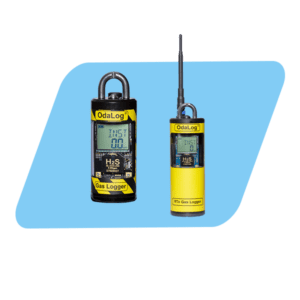Introduction
 Hydrogen sulfide is gas commonly found in wastewater applications produced during the decomposition of organic matter. It is toxic, combustible and can be very corrosive. Monitoring it using a data logger requires an understanding of why the data is being collected and how it is being used to make the right choice in picking the appropriate measurement system.
Hydrogen sulfide is gas commonly found in wastewater applications produced during the decomposition of organic matter. It is toxic, combustible and can be very corrosive. Monitoring it using a data logger requires an understanding of why the data is being collected and how it is being used to make the right choice in picking the appropriate measurement system.
What Is Hydrogen Sulfide?
Hydrogen Sulfide (H2S) is a colorless gas that is often described as having the odor of rotten eggs when present in low concentrations. It is flammable and releases sulfur dioxide (SO2) when burned. It can be toxic at concentrations above approximately 300 ppm. It is also very corrosive to metals, elastomers, and plastics, even to materials like concrete.
Where Does Hydrogen Sulfide Come From?
Hydrogen sulfide can be found in natural sources as unstabilized crude oil, petroleum, and natural gas and can be released when these materials are burned or vaporized. It is also present in volcanic gases, hot springs, and some well water. H2S can be produced by the decomposition of organic materials by naturally occurring bacteria in areas with low oxygen concentrations such as swamps or underground through a process known as anaerobic digestion.
Hydrogen sulfide can also be found in industrial settings such as oil and gas wells, refineries, natural gas processing plants, steel mills, leather tanning facilities, sewage and wastewater pipes and treatment plants, and other types of chemical processing plants.
In wastewater pipes and sewage treatment plants, H2S is produced when anaerobic bacteria digest sulfates and organic material via the reduction reaction:
SO4-2 + Organic Material -> H2S + CO2
If oxygen is present, there is a balancing reaction by aerobic bacteria to oxidize the H2S:
H2S + 2O2 -> H2SO4
Why Is It Important to Monitor Hydrogen Sulfide?
 There are 3 important reasons to monitor H2S
There are 3 important reasons to monitor H2S
- Health and safety issues – As mentioned before, hydrogen sulfide can be toxic at concentrations above 300 ppm and is flammable; at higher concentrations, a mixture of H2S and air can be explosive.
Even at concentrations below the toxic level, it can cause irritation of the eyes nose and throat, headache, nausea, dizziness, and loss of coordination. It is also heavier than air and can pose a hazard if it is allowed to accumulate in pits and other poorly ventilated places.
2. Public nuisance complaints – The rotten egg smell that accompanies H2S can often lead to complaints from residents near manholes, discharge points, treatment plants, landfills, and other types of processing and manufacturing facilities.
3. Infrastructure damage – H2S is corrosive and can lead to degradation of pipes, manholes, lift stations, and pumping equipment.
What Can You Do to Eliminate Hydrogen Sulfide?
The main principles for eliminating H2S revolve around the management of the anaerobic sulfate-reducing bacteria (SRB) that are the source. First, as mentioned before there is a competing reaction that depends on oxygen to convert the hydrogen sulfide to sulfuric acid. Increasing the oxygen level via aeration can reduce the anaerobic reaction, enhance the competing reaction, and reduce H2S levels.
Another method is to reduce the presence of the SRB via a biocide such as chlorine, alkalis, or nitrites. The introduction of nitrates or anthraquinone can change the behavior of the SRB to reduce the formation of H2S. Finally, modifying the operation of the system, for example introducing other friendly bacteria or speeding up flow rate can suppress the activity of SRB.
How Do You Monitor Hydrogen Sulfide?
There are a variety of methods to detect the presence of hydrogen sulfide. The simplest is the sense of smell. Amazingly, it is possible to smell H2S at levels of <1-10 ppm, however, you would not want to be anyplace where the level was >20 ppm for any period of time. There are several methods for chemical detection of H2S including lead acetate coated test strips, colorimetric tubes, and the Tutwiler method which utilizes chemical titration. One of the most accurate methods is gas chromatography but this requires a relatively large and expensive piece of equipment and may not be practical for use in the field.
Finally, there are electronic monitors that utilize small electrochemical sensors to detect H2S. These sensors use a specially treated sensing electrode along with an electrolyte; the incoming gas undergoes a chemical reaction at the sensing electrode that generates an electrical signal. These sensors typically employ a counter and/or reference electrode to provide a differential output signal that is only based on the concentration of the specific gas being measured. One important consideration when using these sensors is that they have a finite operating time when used in the presence of hydrogen sulfide. Since they depend on an electrochemical reaction, there is an electrolyte that is converted as part of the reaction. Eventually, once all of the electrolyte is converted, the sensor can lose its ability to respond to H2S. When this happens, the sensor has to be regenerated by removing it from the monitoring location and placing it in a normal environment to allow it to recover. A good rule of thumb is that the sensor needs to spend an amount of time in the normal environment equal to the amount of time in the monitored environment to fully recover.
Selecting a Hydrogen Sulfide Monitoring System
 When choosing a system to monitor H2S gas levels for a semi-permanent installation (as opposed to a personal protective monitoring unit) there are several considerations to take into account:
When choosing a system to monitor H2S gas levels for a semi-permanent installation (as opposed to a personal protective monitoring unit) there are several considerations to take into account:
- What are the application and associated measurement range?
- Odor control
- Monitoring natural sources
- Health & safety
- Flammability/combustibility monitoring
- Corrosion management
- Treatment/remediation management
- How often will a measurement be taken?
- How long does the unit need to be left in place?
- How much on-board data does the unit need store?
- What is the environment like?
- Does the unit need a real-time display
- How will the data be retrieved?
- Does the unit need any alarm output?
- Does the unit need any real-time output?
In general, odor control applications, for example, monitoring along a fence line or at the output of a scrubber require the ability to measure at low levels typically < 5ppm. Sample rates of 10 minutes to once an hour are commonly used. These are often temporary installations which may last a week or 2 which would require storage for a few thousand data points.
Systems intended for health and safety monitoring would typically need a range up to 100-200 ppm – the OSHA has set a ceiling of 20 ppm continuous with a maximum peak of 50 ppm for a maximum of 10 minutes during an 8-hour shift. This type of application would almost certainly require a real-time display and alarm with a sample rate of 1-10 minutes.
For longer-term projects such as monitoring for corrosion management or treatment, the ability to sense over a wider range, up to several thousand ppm, may be required. These applications can involve monitoring in very harsh, wet or high humidity corrosive environments that require a robust instrument package with O-ring seals. Since these units could be left in place for long periods of time, large internal memory and battery are required to allow extended operation.
To facilitate data retrieval, a wireless interface such as Bluetooth can make it possible to easily download data to a mobile device rather than relying on a hardwired connection to a PC. For unattended data retrieval, a device with an internal cellular modem can automatically push data and alarms to eliminate the need to physically access the logger. Also, these longer-term installations will usually require multiple loggers so that they can be swapped in/out of service to allow recovery after extended use times.
Finally, some applications, such as dosing of a chemical to eliminate the SRB that generate H2S, will require an output signal to connect to an existing system. An H2S data logger that can provide an industry-standard 4-20 mA current output allows the unit to provide a real-time output that can be tied into a SCADA system for equipment control, alarm activation, and long term historical data recording.
For further information on hydrogen sulfide monitoring, or to find the ideal solution for your application-specific needs, contact a CAS Data Logger Application Specialist at (800) 956-4437 or request more information.

